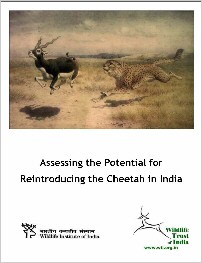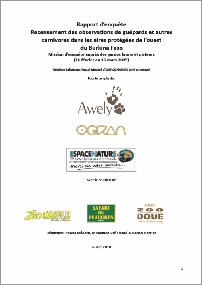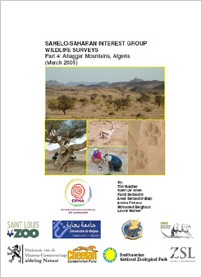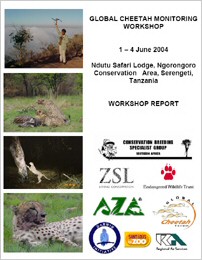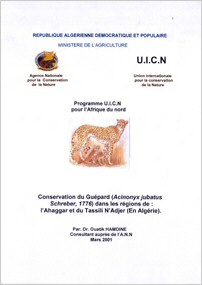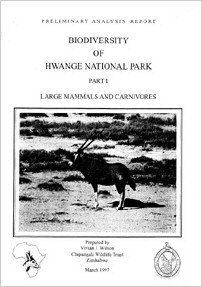|
|
Ranjitsinh MK and Jhala Y.V. Assessing the potential for reintroducing the Cheetah in India. 2010. The cheetah is the only large carnivore that has been extirpated, mainly by over-hunting in India in historical times. India now has the economic ability to consider restoring its lost natural heritage for ethical as well as ecological reasons. In a meeting in Gajner in September 2009 a consensus was reached for conducting a detailed survey in selected sites to explore the potential of reintroducing the cheetah in India. The Honourable Minister of Environment and Forests, Shri Jairam Ramesh, mandated the Wildlife Institute of India and the Wildlife Trust of India with this task. |
|
|
|
|
|
Purchase G, Kelly D, Purchase D, and Nyoni W. Cheetahs, wild dogs and climate change. 2010. Use of a DVD to present a lesson to increase the awareness of high school students (aged 16 -20) in Zimbabwe to climate change and related cheetah and wild dog conservation issues (Pilot project) |
|
|
|
|
|
Rabeil T., Beudels-Jamar R. and Greth A. 2010. Report on the Mission in Kellé and Termit-Tin Toumma, February 2010. During the mission several carnivores’ tracks were identified: honey badger, African lynx, striped hyena and cheetah. Surveys by camel and on foot are appropriate for collecting information about cheetah, and several tracks were recorded during this mission, improving the knowledge of status of the elusive, enigmatic cheetah in Termit. |
|
|
|
|
|
Médard P., Traoré, M.V., Berzins R. 2010. Rapport d’enquête - Recensement des observations de guépards et autres carnivores dans les aires protégées du l’ouest du Burkina Faso - Mission d’enquête auprès des gardes faunes de l’ouest du Burkina -Faso (16 février au 16 mars 2009). Awely pp.53.
|
|
|
|
|
|
Fulconis R. and Berzins R. 2007. Poursuite des activités de « Conservation du guépard et développement durable dans les aires protégées du Nord Bénin ». Rapport de la mission Bénin – Niger 20 avril – 5 mai 2007
The coordination of OGRAN/NARCAG has been taken over by the organisation Awely. Its director Renaud Fulconis and Rachel Berzins have visited Benin to follow up with the earlier activities and to meet with the relevant people to prepare the upcoming OGRAN meeting in Benin in spring 2008.
|
|
|
|
|
|
Berzins R., Claro F., Akpona A.H. and Alfa Gambari Imorou S. 2007. Conservation du guépard et développement durable dans les aires protégées du nord Bénin. Mission d'enquête auprès des villageois et des agents d'aires protégées (16/12/2005-26/02/2006). In French.
The status of the cheetah in northern Benin was evaluated by interviewing local people and wardens of the Pendjari Biosphere Reserve and the regional park W Benin. The project was implemented by a French-Benin team. A total of 64 people have been interviewed. Besides data on cheetahs also observations on lions, leopards and hyenays were collected.
Zoological
Society Paris, 57 pp. |
|
|
|
|
|
Berzins R. and Belbachir F. 2007 Compte-rendu de la 2ème réunion de l'Observatoire du Gépard en Régions d'Afrique du Nord. 20-25 Novembre 2006, Tamanrasset Alérie (Report of the 2nd meeting of NARCAG in Tamanrasset, Algeria, November '06)
The second meeting of the North African Regions Cheetah Action Group was hold in Tamanrasset, Algeria. In a first part, the situation in Northern Africa was presented in a series of presentations. In the second part, various aspects of cheetah conservation was discussed in a round table discussion. The meeting was followed by a three days trip to the Ahaggar National Parc.
Zoological Society Paris, 36 pp. Berzins_&_Belbachir_2007_Report_of_OGRAN_meeting_in_Tamanrasset.pdf |
|
|
|
|
|
Busby,G.; Gottelli,D.; Wacher,T.; Durant,S.; Marker,L.; Belbachir,F.; De Smet,K.; Belbachir-Bazi,A.; Fellous,A.; Belghoul,M. 2006. A report from the Sahelo Saharan Interest Group - Parc National de L'Ahaggar survey, Algeria (March 2005), Part 5: Using molecular genetics to study the presence of endangered carnivores (November 2006)
A joint 2005 expedition to the Ahaggar region of the Algerian Sahara collected over 40 putative carnivore scat samples for further analysis. The first major objective of this analysis was to assign species identity to the scat. This was done through genetic analyses of the samples. Among other carnivores, eight cheetahs and a leopard were found.
Busby_et_al_2006_Molecular_genetics_of_cheetahs_in_Algeria.pdf |
|
|
|
|
|
Wacher,T.,
de Smet,K., Belbachir,F., Belbachir-Bazi,A., Fellous,A.,
Belghoul,M. and Marker,L. 2005.
This report summarizes results of a gazelle and cheetah survey of the central zone of the Ahaggar National Park, 7 - 23 March, 2005. The objective was to conduct a wildlife reconnaissance survey of little visited areas focusing simultaneously on distribution and relative abundance of cheetah and their prey base, particularly gazelles.
Wacher_et_al_2005_Wildlife_survey_in_the_central_Ahaggar_Mountains.pdf Wacher_et_al_2005_Wildlife_survey_in_the_central_Ahaggar_Mountains_French.pdf |
|
|
|
|
|
Bashir S, Daly B, Durant SM, Förster H, Grisham J, Marker L, Wilson K, Friedmann Y, editors. 2004. Global Cheetah (Acinonyx jubatus) Monitoring Workshop.
To address the need for cohesive global action to conserve cheetah, two Global Cheetah Conservation Action Planning workshops were held in South Africa in 2000 and 2001, resulting in the development of a global master plan for conserving cheetah. Cheetah conservationists from 14 countries contributed to the development of the Global Cheetah Action Plan at both workshops The Action Plan stresses the need for accurate census and monitoring data as cheetah conservation efforts are being hindered by a lack of reliable data on numbers, distribution and population trends. In June 2004, an international Cheetah Monitoring Workshop was therefore held at Ndutu Safari Lodge in the Ngorongoro Conservation Area in Tanzania, to address these issues.
IUCN/SSC Conservation Breeding Specialist Group, 87 pp. |
|
|
|
|
|
Claro F. and Sissler C. 2002. Rapport de mission scientifique au Niger dans la region du Termit (Survey of the Termit region in Niger)
During a field survey in the Termit area in Niger, 48 cheetah tracks were discovered, of which 14 were from groups of two animals. 5 cheetahs have been observed, two of them from less than 200 m. 11 prey remains were attributed to cheetahs, all of them dorcas gazelles. The report also provides detailed description on cheetah's prey species.
Claro_&_Sissler_2002_Survey_of_the_Termit_region_in_Niger.pdf |
|
|
|
|
|
Hamdine, O. 2001 Conservation du Guépard (Acinonyx jubatus, Schreber 1776) dans les régions de: l'Ahaggar et du Tassili N'Adjer (en Algéie)
Conservation of the Cheetah in the region of l'Ahaggar and Tassili N'Adjer in Algeria
In the 19th century the cheetah inhabited probably all the Sahara, but today it has disappeared in numerous areas and is seriously menaced of disappearance. Recent observations report the cheetah in the Lassili N'Adjer and the Hoggar regions, where its presence seems actually very likely.
A.N.N. and IUCN 50 pp. |
|
|
|
|
|
Jacobs,M.J.; Schloeder,C.A. 2001. Impacts of conflict on biodiversity and protected areas in Ethiopia
Ethiopia possesses considerable biodiversity and natural resources, as well as many endemic species. It has had, however, only limited success protecting some of these natural assets since establishing a conservation and protected area program in 1965, due to the country's prolonged engagement in various armed conflicts. The result has been, in the last 25 years, an increase in the number of threatened and endangered species and deleterious habitat modifications. Also, much destruction of protected-area assets has occurred. Deforestation, farming, overgrazing, hunting, and soil erosion all were conflict-related factors that led to these changes and limited the success of Ethiopia's conservation and protected-area program.
Biodiversity Support Program, Washington D.C. 45 pp. Jacobs_&_Schloeder_2001_Biodiversity_and_protected_areas_in_Ethiopia.pdf |
|
|
|
|
|
Wilson V. 1997. Biodiversity of Hwange National Park - Part I: Large Mammals and CarnivoresPreliminary analysis report
Surveys were carried out in 1969-71 and 1996. The status of many large mammals has changed considerably over these 25 years. While the elephant population has doubled, the buffalo's one has halved. Lions, leopards and hyenas numbers have doubled, while cheetahs number have declined considerably, which is possibly due to increased numbers of the other large carnivores in the Park.
Wilson_1997_Biodiversity_of_Hwange_National_Park_Zimbabwe.pdf Wilson_1997_Biodiversity_of_Hwange_National_Park_Zimbabwe_-_Results.pdf |
|
|
|
